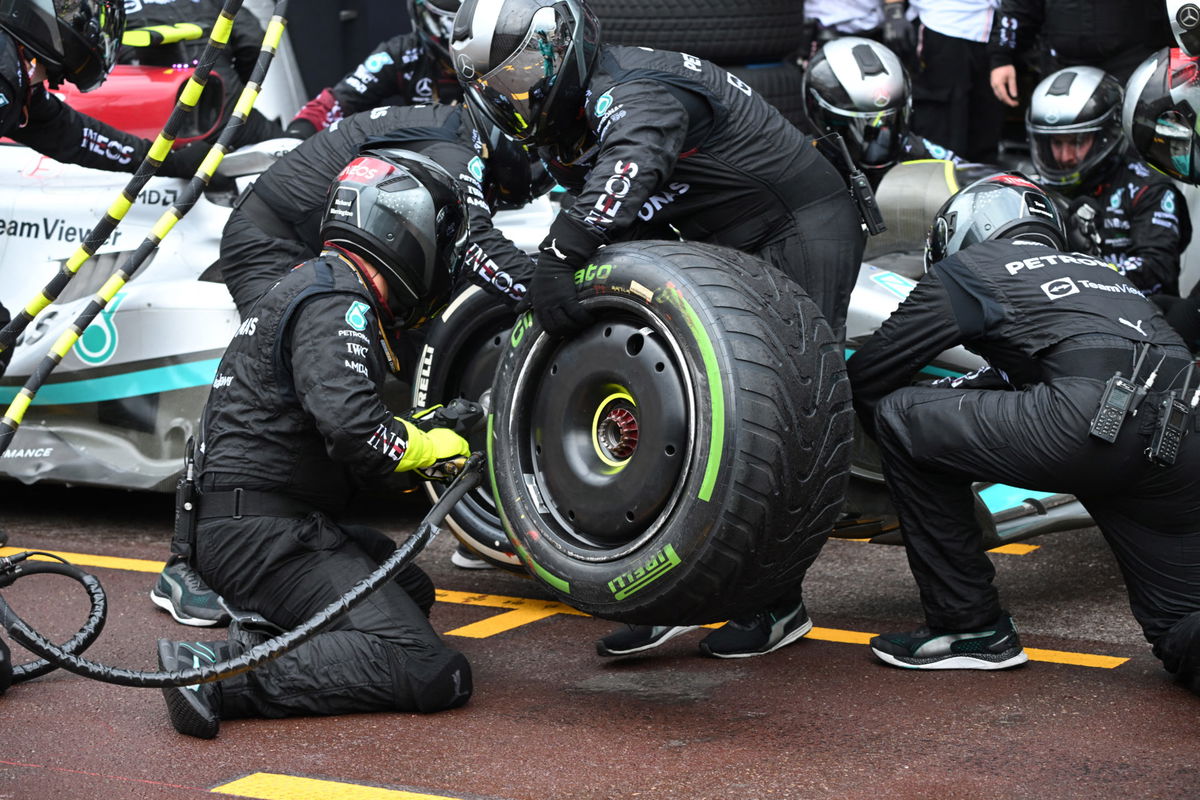
Reuters
Formula One F1 – Monaco Grand Prix – Circuit de Monaco, Monte Carlo, Monaco – May 29, 2022 Mercedes team members in action as Lewis Hamilton makes a pit stop during the race Pool via REUTERS/Christian Bruna

Reuters
Formula One F1 – Monaco Grand Prix – Circuit de Monaco, Monte Carlo, Monaco – May 29, 2022 Mercedes team members in action as Lewis Hamilton makes a pit stop during the race Pool via REUTERS/Christian Bruna
In Formula 1, there’s nothing that attracts fans more than the sound of the wheel gun fastening and loosening the wheel nuts during pit stops. After all, a sound heard for less than a few seconds for the entire race is more crucial to its outcome than many would think. Just ask Valtteri Bottas about his pit stop during the 2021 Monaco GP which turned the Finn’s race upside down owing to a faulty wheel nut.
Watch What’s Trending Now!
But while that particular stop may have lasted over an entire day, the main reason behind F1’s sub-two-second pit stops today majorly comes down to the wheel gun made by Paoli. Founded in 1968, the Italian company has made significant progress throughout the years to provide the sport with top-of-the-line wheel guns that can cost upward of $30,000! As we inch close to Paoli’s 60th Anniversary, let’s take a closer look at the wheel gun.
ADVERTISEMENT
Mercedes mechanic dissects the F1 wheel gun and how it’s used
Firstly, it’s important to understand just how the wheel gun works to gauge how its efficient use can be the difference between finishing first and last. In a video shared by Mercedes on YouTube, Aaron Jeeves, who was the front-end mechanic on Valtteri Bottas’ challenger, walked us through the workings of a wheel gun and how they are used in action.
ADVERTISEMENT
Jeeves shared that the wheel guns are operated with compressed air and are connected to the pit stop gantry which allows it to transfer data related to the functioning of the wheel gun and the efficiency of the handler. This data in turn allows the team to analyse pit-stop performances using metrics other than cameras and the car’s on-board sensors. The equipment itself weighs approximately 10 pounds with a maximum pressure of 362 PSI. This amount of pressure allows the guns to achieve an RPM of over 15,000.
ADVERTISEMENT
The Finnish driver’s former wheelman shared further insight, “The gun operates by pulling the trigger, which will either tighten or loosen the wheel nut. Once you pull the trigger, it will loosen the wheel nut, it will automatically shuttle, and the next you pull the trigger, it will tighten the wheel nut.” While this may be the case 99% of the time, a wheel gun may also fail to loosen a faulty wheel nut, as was the case with Bottas’ 2021 challenger.
Top Stories
US Government Official Professes Love for NASCAR While Building a Formula One Passion

Max Verstappen’s Siblings: Everything We Know About Victoria, Blue Jaye, Jason Jaxx, and Mila Faye

Carlos Sainz Debunks Biggest ‘Smooth Operator’ Myth After Its Return at Australian GP

“Is This Alex or Charlotte?”: Charles Leclerc’s Cozy Image Triggers Confusion as Blast From the Past Sends F1 Fans Into a Frenzy

Was Lewis Hamilton the First Black F1 Driver in History?

A wheel nut on the #77 Mercedes would not come loose despite switching to the spare wheel gun, leading to the longest pit-stop in F1’s history. Although the issue was created by the wheel nut and not the wheel gun, the art of perfecting pit stops is vital to avoid situations like the 2021 Monaco GP. While the wheel nut may still need to be worked upon, Paoli has taken every step to ensure the best materials are used for the wheel guns.
ADVERTISEMENT
Here’s why Formula 1 teams exclusively use Paoli wheel guns
The reason the name Paoli is synonymous with an F1 wheel gun is because of their long history as the supplier to all ten F1 teams. Not only are their wheel guns utilized by the pinnacle of motorsport but can also be seen in some of America’s favorite categories such as NASCAR and IndyCar. What began as an air-powered impact wrench company marketing toward general applications would become F1’s go-to pit-stop masters after an invitation from Enzo Ferrari in 1975. Since then, the company has seen immense innovation alongside F1’s improvements.
To match the engineering that goes behind a Formula 1 car and subsequently, its pitstops, Paoli has left no stone unturned in the development of their wheel gun. Implementing materials such as Aluminium ergal, an aluminium alloy made up of zinc, copper, magnesium, silicon, iron, manganese, titanium and chromium. This compound allows the guns to withstand over 3,000 lbs of force and reduces the risk of failure during a pit stop.
Whilst carbon fiber is all the craze for F1 teams, the goal is not the same with a wheel gun and hence we see less and less of the material being used by Paoli. Andrea Ori, a technician at Paoli was quoted by Popular Mechanics, “We only have the front cover, the nose of the gun in carbon fibre… we could save 10–50 grams on the gun in the end, but we would prefer to have an aluminium cover to have more durability and more precision due to their tolerances.”
ADVERTISEMENT
The reason behind the team’s exclusive success in Formula 1 stretches far beyond Enzo Ferrari’s initial invitation, as the team have mastered the art of manufacturing the wheel gun so teams can clock record-break pit-stops which have reached sub-two seconds. This is largely because the company is one of the only wheel gun manufacturers in the world that assembles and fabricates all internals in-house at their facility in Reggio Emilia, Italy.
The reason this ability is so important for Paoli to focus on lies becomes evident once we understand that a Formula 1 team’s goal with pit stops isn’t speed as much as it is stability.
ADVERTISEMENT
In the world of pit-stops, consistency beats speed while practice leads to perfection
Picture this, if you were an F1 team boss in a three-stop strategy race and had to choose between one sub-two second pit-stop and two that exceed three seconds or triple 2.5 second pitstops, what would be your answer? If it was the more constant 2.5, then your response would be perfectly aligned with most team principles. After all, a few tenths during a pitstop can be the difference between maintaining the lead or losing out on track position, the latter of which could prove disastrous.
The technical office manager at Paoli, Mirco Grassi, reflected similar thoughts as he shared, “In Formula 1 they are not searching for the fastest stop, but they are searching to be stable and consistent. A possible threshold would be to have 80 per cent of the pitstops under 2.7 and 2.8 seconds.” We’ve all seen moments where an undercut has failed owing to a lengthy pit stop and teams hope to minimize this risk as it stands the chance of ruining their entire strategy.
ADVERTISEMENT
But to control this calamity, teams don’t just leave it up to the equipment manufacturers to increase efficiency. While it’s true that times have come down by seconds owing to innovations in the center-locking mechanism as well as through monitoring various data, nothing is more vital to the timings of a pit stop than the coordination between the pit crew.
In the video released by Mercedes that we mentioned earlier, wheelman Aaron Jeeves also dived deeper into the preparations the pit crew made before the Grand Prix. He shared, “On our pit-stop crew, there are four-wheel gunmen, one for each corner. We start practice each week on the Thursday and we tend to do around 50 practice pitstops throughout the weekend. During each practice session, we will do a live practice pitstop on the car, just to get as used to the real situation as we can.”
WATCH THIS STORY: Biggest Pitlane Mishaps Featuring Hamilton, Raikkonen & Verstappen
ADVERTISEMENT
After taking a look at how the wheel gun works and helps F1 teams accomplish fast and consistent pit stops, do you think we will see another big innovation by Paoli soon?
ADVERTISEMENT
ADVERTISEMENT
ADVERTISEMENT

